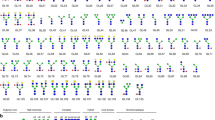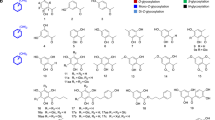Abstract
Glycosyltransferases (Gtfs) catalyze the formation of a diverse array of glycoconjugates. Small-molecule inhibitors to manipulate Gtf activity in cells have long been sought as tools for understanding Gtf function. Success has been limited because of challenges in designing inhibitors that mimic the negatively charged diphosphate substrates. Here we report the mechanism of action of a small molecule that inhibits O-linked N-acetylglucosamine transferase (OGT), an essential human enzyme that modulates cell signaling pathways by catalyzing a unique intracellular post-translational modification, β-O-GlcNAcylation. The molecule contains a five-heteroatom dicarbamate core that functions as a neutral diphosphate mimic. One dicarbamate carbonyl reacts with an essential active site lysine that anchors the diphosphate of the nucleotide-sugar substrate. A nearby cysteine then reacts with the lysine adduct to form a carbonyl crosslink in the OGT active site. Though this unprecedented double-displacement mechanism reflects the unique architecture of the OGT active site, related dicarbamate scaffolds may inhibit other enzymes that bind nucleotide-containing substrates.
This is a preview of subscription content, access via your institution
Access options
Subscribe to this journal
Receive 12 print issues and online access
$259.00 per year
only $21.58 per issue
Buy this article
- Purchase on Springer Link
- Instant access to full article PDF
Prices may be subject to local taxes which are calculated during checkout




Similar content being viewed by others
References
Varki, A. et al. Essentials of Glycobiology 2nd edn. (Cold Spring Harbor Laboratory Press, 2009).
Kiessling, L.L. & Splain, R.A. Chemical approaches to glycobiology. Annu. Rev. Biochem. 79, 619–653 (2010).
Wagner, G.K. & Pesnot, T. Glycosyltransferases and their assays. ChemBioChem 11, 1939–1949 (2010).
Brown, J.R., Crawford, B.E. & Esko, J.D. Glycan antagonists and inhibitors: a fount for drug discovery. Crit. Rev. Biochem. Mol. Biol. 42, 481–515 (2007).
Pesnot, T., Jorgensen, R., Palcic, M.M. & Wagner, G.K. Structural and mechanistic basis for a new mode of glycosyltransferase inhibition. Nat. Chem. Biol. 6, 321–323 (2010).
Frantom, P.A., Coward, J.K. & Blanchard, J.S. UDP-(5F)-GlcNAc acts as a slow-binding inhibitor of MshA, a retaining glycosyltransferase. J. Am. Chem. Soc. 132, 6626–6627 (2010).
Lairson, L.L., Henrissat, B., Davies, G.J. & Withers, S.G. Glycosyltransferases: structures, functions, and mechanisms. Annu. Rev. Biochem. 77, 521–555 (2008).
Trunkfield, A.E., Gurcha, S.S., Besra, G.S. & Bugg, T.D. Inhibition of Escherichia coli glycosyltransferase MurG and Mycobacterium tuberculosis Gal transferase by uridine-linked transition state mimics. Bioorg. Med. Chem. 18, 2651–2663 (2010).
Izumi, M., Yuasa, H. & Hashimoto, H. Bisubstrate analogues as glycosyltransferase inhibitors. Curr. Top. Med. Chem. 9, 87–105 (2009).
Skropeta, D., Schworer, R., Haag, T. & Schmidt, R.R. Asymmetric synthesis and affinity of potent sialyltransferase inhibitors based on transition-state analogues. Glycoconj. J. 21, 205–219 (2004).
Wang, R. et al. A search for pyrophosphate mimics for the development of substrates and inhibitors of glycosyltransferases. Bioorg. Med. Chem. 5, 661–672 (1997).
Helm, J.S., Hu, Y., Chen, L., Gross, B. & Walker, S. Identification of active-site inhibitors of MurG using a generalizable, high-throughput glycosyltransferase screen. J. Am. Chem. Soc. 125, 11168–11169 (2003).
Hang, H.C. et al. Small molecule inhibitors of mucin-type O-linked glycosylation from a uridine-based library. Chem. Biol. 11, 337–345 (2004).
Gloster, T.M. et al. Hijacking a biosynthetic pathway yields a glycosyltransferase inhibitor within cells. Nat. Chem. Biol. 7, 174–181 (2011).
Hart, G.W., Housley, M.P. & Slawson, C. Cycling of O-linked β-N-acetylglucosamine on nucleocytoplasmic proteins. Nature 446, 1017–1022 (2007).
Love, D.C. & Hanover, J.A. The hexosamine signaling pathway: deciphering the “O-GlcNAc code”. Sci. STKE 2005, re13 (2005).
Boyce, M. et al. Metabolic cross-talk allows labeling of O-linked β-N-acetylglucosamine-modified proteins via the N-acetylgalactosamine salvage pathway. Proc. Natl. Acad. Sci. USA 108, 3141–3146 (2011).
Dong, D.L. & Hart, G.W. Purification and characterization of an O-GlcNAc selective N-acetyl-beta-D-glucosaminidase from rat spleen cytosol. J. Biol. Chem. 269, 19321–19330 (1994).
Macauley, M.S. & Vocadlo, D.J. Increasing O-GlcNAc levels: an overview of small-molecule inhibitors of O-GlcNAcase. Biochim. Biophys. Acta 1800, 107–121 (2010).
Hanover, J.A., Krause, M.W. & Love, D.C. The hexosamine signaling pathway: O-GlcNAc cycling in feast or famine. Biochim. Biophys. Acta 1800, 80–95 (2010).
Zeidan, Q. & Hart, G.W. The intersections between O-GlcNAcylation and phosphorylation: implications for multiple signaling pathways. J. Cell Sci. 123, 13–22 (2010).
Hart, G.W., Slawson, C., Ramirez-Correa, G. & Lagerlof, O. Cross talk between O-GlcNAcylation and phosphorylation: roles in signaling, transcription, and chronic disease. Annu. Rev. Biochem. 80, 825–858 (2011).
Hu, P., Shimoji, S. & Hart, G.W. Site-specific interplay between O-GlcNAcylation and phosphorylation in cellular regulation. FEBS Lett. 584, 2526–2538 (2010).
Slawson, C., Copeland, R.J. & Hart, G.W. O-GlcNAc signaling: a metabolic link between diabetes and cancer? Trends Biochem. Sci. 35, 547–555 (2010).
Yang, X. et al. Phosphoinositide signalling links O-GlcNAc transferase to insulin resistance. Nature 451, 964–969 (2008).
Hu, Y. et al. Identification of selective inhibitors for the glycosyltransferase MurG via high-throughput screening. Chem. Biol. 11, 703–711 (2004).
Gross, B.J., Kraybill, B.C. & Walker, S. Discovery of O-GlcNAc transferase inhibitors. J. Am. Chem. Soc. 127, 14588–14589 (2005).
Alexander, J.P. & Cravatt, B.F. Mechanism of carbamate inactivation of FAAH: implications for the design of covalent inhibitors and in vivo functional probes for enzymes. Chem. Biol. 12, 1179–1187 (2005).
Kreppel, L.K. & Hart, G.W. Regulation of a cytosolic and nuclear O-GlcNAc transferase. Role of the tetratricopeptide repeats. J. Biol. Chem. 274, 32015–32022 (1999).
Ten Hagen, K.G. et al. Cloning and expression of a novel, tissue specifically expressed member of the UDP-GalNAc:polypeptide N-acetylgalactosaminyltransferase family. J. Biol. Chem. 273, 27749–27754 (1998).
Lazarus, M.B., Nam, Y., Jiang, J., Sliz, P. & Walker, S. Structure of human O-GlcNAc transferase and its complex with a peptide substrate. Nature 469, 564–567 (2011).
Friesner, R.A. et al. Glide: a new approach for rapid, accurate docking and scoring. 1. Method and assessment of docking accuracy. J. Med. Chem. 47, 1739–1749 (2004).
Halgren, T.A. et al. Glide: a new approach for rapid, accurate docking and scoring. 2. Enrichment factors in database screening. J. Med. Chem. 47, 1750–1759 (2004).
Friesner, R.A. et al. Extra precision glide: docking and scoring incorporating a model of hydrophobic enclosure for protein-ligand complexes. J. Med. Chem. 49, 6177–6196 (2006).
Konrad, R.J. et al. Alloxan is an inhibitor of the enzyme O-linked N-acetylglucosamine transferase. Biochem. Biophys. Res. Commun. 293, 207–212 (2002).
Hajduch, J. et al. A convenient synthesis of the C-1-phosphonate analogue of UDP-GlcNAc and its evaluation as an inhibitor of O-linked GlcNAc transferase (OGT). Carbohydr. Res. 343, 189–195 (2008).
Vocadlo, D.J. & Davies, G.J. Mechanistic insights into glycosidase chemistry. Curr. Opin. Chem. Biol. 12, 539–555 (2008).
Gloster, T.M. & Davies, G.J. Glycosidase inhibition: assessing mimicry of the transition state. Org. Biomol. Chem. 8, 305–320 (2010).
Rempel, B.P. & Withers, S.G. Covalent inhibitors of glycosidases and their applications in biochemistry and biology. Glycobiology 18, 570–586 (2008).
Dorfmueller, H.C. et al. Cell-penetrant, nanomolar O-GlcNAcase inhibitors selective against lysosomal hexosaminidases. Chem. Biol. 17, 1250–1255 (2010).
Kim, E.J., Perreira, M., Thomas, C.J. & Hanover, J.A. An O-GlcNAcase-specific inhibitor and substrate engineered by the extension of the N-acetyl moiety. J. Am. Chem. Soc. 128, 4234–4235 (2006).
Vijayalakshmi, J., Meyer, E.F. Jr., Kam, C.M. & Powers, J.C. Structural study of porcine pancreatic elastase complexed with 7-amino-3-(2-bromoethoxy)-4-chloroisocoumarin as a nonreactivatable doubly covalent enzyme-inhibitor complex. Biochemistry 30, 2175–2183 (1991).
Drawz, S.M. & Bonomo, R.A. Three decades of beta-lactamase inhibitors. Clin. Microbiol. Rev. 23, 160–201 (2010).
Martinez-Fleites, C. et al. Structure of an O-GlcNAc transferase homolog provides insight into intracellular glycosylation. Nat. Struct. Mol. Biol. 15, 764–765 (2008).
Adams, P.D. et al. PHENIX: a comprehensive Python-based system for macromolecular structure solution. Acta Crystallogr. D Biol. Crystallogr. 66, 213–221 (2010).
Emsley, P., Lohkamp, B., Scott, W.G. & Cowtan, K. Features and development of Coot. Acta Crystallogr. D Biol. Crystallogr. 66, 486–501 (2010).
Bricogne, G. et al. BUSTER Version 2.9 (Global Phasing Ltd., 2010).
DeLano, W.L. The PyMOL GMolecular Graphics System. (Delano Scientific, 2002).
Acknowledgements
We thank J. Brugge (Harvard Medical School) for the MCF-10A ErbB2 cells, L. Tabak (US National Institutes of Health, NIH) for ppGalNAcT2 protein, T. Lupoli (Harvard University) for MurG protein, C. Walsh, N. Gray (Harvard Medical School), E. Jacobson and D. Ford (Harvard University) for helpful discussions and A. Saghatelian (Harvard University) for critical reading of the manuscript. LC/MS data was acquired on an Agilent 6520 Q-TOF spectrophotometer supported by the Taplin Funds for Discovery Program (S. Walker). This work was supported in part by the NIH (GM076710) and the Harvard Biomedical Accelerator Fund.
Author information
Authors and Affiliations
Contributions
S.W. oversaw all aspects of the experiments and manuscript preparation. J.J. carried out all experiments except those involving X-ray crystallography and molecular docking. M.B.L. obtained OGT-inhibitor crystals, acquired data and solved the structure of the crosslinked protein. L.P. conducted molecular docking experiments. P.S. guided refinement of the X-ray crystal structure and molecular docking. J.J. and S.W. wrote the manuscript, and all coauthors participated in figure preparation and editing.
Corresponding author
Ethics declarations
Competing interests
The authors declare no competing financial interests.
Supplementary information
Supplementary Text and Figures
Supplementary Methods and Supplementary Results (PDF 1127 kb)
Rights and permissions
About this article
Cite this article
Jiang, J., Lazarus, M., Pasquina, L. et al. A neutral diphosphate mimic crosslinks the active site of human O-GlcNAc transferase. Nat Chem Biol 8, 72–77 (2012). https://doi.org/10.1038/nchembio.711
Received:
Accepted:
Published:
Issue Date:
DOI: https://doi.org/10.1038/nchembio.711
This article is cited by
-
Amino acid tethered benzoxazolone as highly potent inhibitors of O-glycosylation
Chemical Papers (2024)
-
O-GlcNAcylation as a Therapeutic Target for Alzheimer’s Disease
NeuroMolecular Medicine (2020)
-
O-GlcNAc transferase regulates centriole behavior and intraflagellar transport to promote ciliogenesis
Protein & Cell (2020)
-
Ciliary defects caused by dysregulation of O-GlcNAc modification are associated with diabetic complications
Cell Research (2019)
-
Discovery of a Low Toxicity O-GlcNAc Transferase (OGT) Inhibitor by Structure-based Virtual Screening of Natural Products
Scientific Reports (2017)



